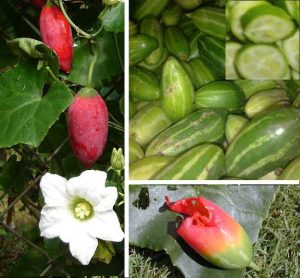BOTANICAL NAME: Coccinia indica
FAMILY: Cucurbitaceae
CLASSICAL CLASSIFICATION:
Charaka: Moolni
Sushruta: Urdgwabagahara
Bhavaprakasha: Shaka varga
ENGLISH NAME: Ivy gourd
COMMON NAME:
Hindi: Kandoori, Koonari
Punjabi: Kunduru, Kunduri
Kannada: Tondekai
Bengali: Telakucha

REFERENCE: BHAVAPRAKASH SAMHITA with link e Nighantu:
https://niimh.nic.in/ebooks/e-Nighantu/bhavaprakashanighantu/?mod=read
HABITAT: Cultivated in Assam, West Bengal, Bihar, Orissa, Maharashtra, Andhra Pradesh, Tamil Nadu; wild in many parts of India.
BOTANICAL DESCRIPTION: Extensive vine; tendrils simple. Leaves 3-7 x 3-5 cm, palmately 3-5-lobed or angled, broadly ovate to orbicular in outline, base cordate, margin denticulate, apex acute, upper surface punctate, lower surface glandular; petiole 2.5-5 cm long. Flowers axillary, solitary. Flowering & fruiting during June to August.
AYURVEDIC CHARACTERISTICS:
| RASA | GUNA | VEERYA | VIPAKA | PRABHAVA | DOSHGHNTA |
| Kashaya, Madhura, Tikta | Laghu | Sheeta | Katu | – | Kaphapittasamaka |
AYURVEDIC ENERGETICS:
| TASTE | PROPERTY | POTENCY | POST DIGESTION EFFECT | ACTION | DOSHA ACTION |
| Astringent, Sweet, Bitter | Light | Cold | Pungent | – | Kapha pitta pacifying |
MAJOR CHEMICAL CONSTITUENTS: Resins, Alkaloids, fatty acids, flavonoids and proteins
THERAPEUTIC USES:
- Bed wetting: Root paste is to be given daily in a dose of 3 to 5 gm
- Wounds: Fresh juice of leaves is to be given in a dose of 10 to 15 ml
- Diabetes: Fresh juice of root and leaves is to given in 15 to 20 ml dose
- Eczema: Leaves paste is to be applied externally.
INDICATIONS:
Kasa Cough, Pandu Anemia, Kamala Jaundice, Shawasa Asthma
USEFUL PART: Fruit, leaf, flower, root, stem
DOSAGE: Whole plant 3-6 gm powder, 5-10 ml juice
AYURVEDIC FORMULATION:
Vatsyamantaka ghrita
